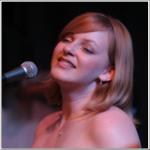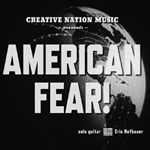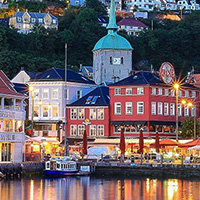Home » Jazz Articles » Live Review » Norwegian Jazz 101b: JazzNorway in a Nutshell 2010
Norwegian Jazz 101b: JazzNorway in a Nutshell 2010
With some of the JNiaN attendees leaving early the next morning, the final full evening of the junket kicked off with Motif in the Sardinen room of USF Verftet. While some of the post-Miles Davis free-bop that defined its last release, Apo Calypso (Jazzland, 2008), remained, the 11-year-old quintet's exhilarating performance also demonstrated the significance of even a single change in a longstanding lineup. With trumpeter Mathias Eick no longer in the group (his solo career having kicked into higher gear), the remaining members of the group—pianist Håvard Wiik, saxophonist/clarinetist Atle Nymo, bassist Ole Morten Vågan and drummer Håkon Mjåset Johansen—were joined by Axel Dørner, a far freer trumpeter who took the group into even more extreme territory than it had previously visited.
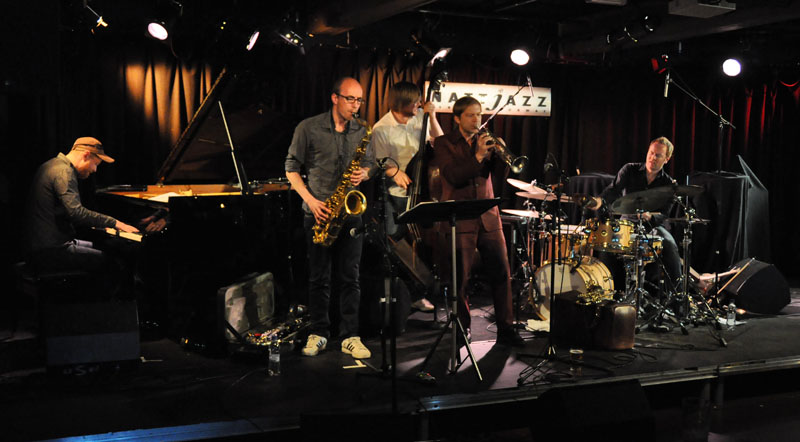 From left Håvard Wiik, Atle Nymo, Ole Morten Vågan Axel Dørner, Håkon Mjåset Johansen
From left Håvard Wiik, Atle Nymo, Ole Morten Vågan Axel Dørner, Håkon Mjåset Johansen Of course, the combination of Wiik—whose constant ability to surprise amid his virtuosic explorations of every part of his instrument—and the flexible but fervent team of Vågan and Johansen, meant that whether Motif was swinging hard or exploring the outer reaches of free improvisation with reckless abandon, there was always a clear sense of commitment and intent, not to mention no shortage of fun being had by all. Nymo is a player who, while slowly emerging on the international radar, has become an increasingly busy saxophonist in Norway, performing with Helge Sunde's Ensemble Denada on on Finding Nymo (ACT, 2009) as well as in the bands Juxtaposed, IPA, Hilde Louise Asbjørnsen Orchestra and Saxwaffe. A broad player who can play with the deep tone of Dexter Gordon one moment, the piercing multiphonics and wails of Peter Brötzmann the next, he was a simpatico foil for Dørner, whose explorations of extended techniques and use of circular breathing created some of the set's most exciting moments, both alone and in tandem with Nymo.
The only non-Norwegian of the group (born and living in Germany), Dørner brings a new dimension to Motif. Known for his participation in the Ken Vandermark axis (a member of the American reed man's Territory Band), as well as past work with iconic German pianist Alexander von Schlippenbach and American saxophonist Sam Rivers, Dørner's playing was mesmerizing, whether navigating the knotty arrangement of "Paddywank"—which effortlessly moved between fiery swing, intense free play, creating a constantly shifting foundation for Nymo's best solo of the set—or taking front and center stage for an a capella solo that combined abstruse melodism, raspy sonics and a wash of faux-white noise.
Vågan, the group's spokesperson, demonstrated the same unfettered approach as with Maria Kannegaard the previous night—plucking, slapping, popping and strumming the strings with relentless intensity. But here, teamed with Johansen—a fellow partner in groups including Maryland (with Kannegaard and saxophonist Håkon Kornstad) and Wiik's trio—and a repertoire that emphasized power and frenzy over the more considered free play of Kannagaard's trio with drummer Thomas Strønen, there was even greater opportunity to witness his ability to drive a pulse but play simultaneously with complete and utter freedom. He also proved capable, in a duet with Nymo on bass clarinet, of a rich arco and, perhaps surprisingly, deeper beauty.
The set list appeared to be all new material, and if the stunning interaction of its Nattjazz performance was any indication, Motif needs to gets back into the studio, and quickly, to document this revised lineup. Comfortably marrying detailed structure with unabashed and unapologetic freedom, much of its music may not have been for the faint-at-heart, but Motif's stunning blurring of the line between form and freedom made for one thrilling show.
May 28, 2010: Stian Westerhus
Since returning home after spending a few years in England, Norwegian guitarist Stian Westerhus has acquired the moniker "The Hardest Working Guitar Player in Jazzbiz," and it's an apt one. Last year, at Molde, he could be seen challenging the outer reaches of free improvisation with Crimetime Orchestra, and only a couple hours later adding his jagged sonics to the more strictly arranged music of Jaga Jazzist. He can also be heard with Monolithic and Puma (whose latest disc, Half Nelson Courtship ((2010)) has just been released by Rune Grammofon)—and on his own solo guitar release, Pitch Black Star Spangled (Rune Grammofon, 2010)—but the gig that is, perhaps, pushing him up into a larger audience's radar is with trumpeter Nils Petter Molvær. Westerhus replaced another marvelous guitar innovator, Eivind Aarset, in Molvær's group last year, and the tour schedule so far has been beyond hectic, but in a very good way.
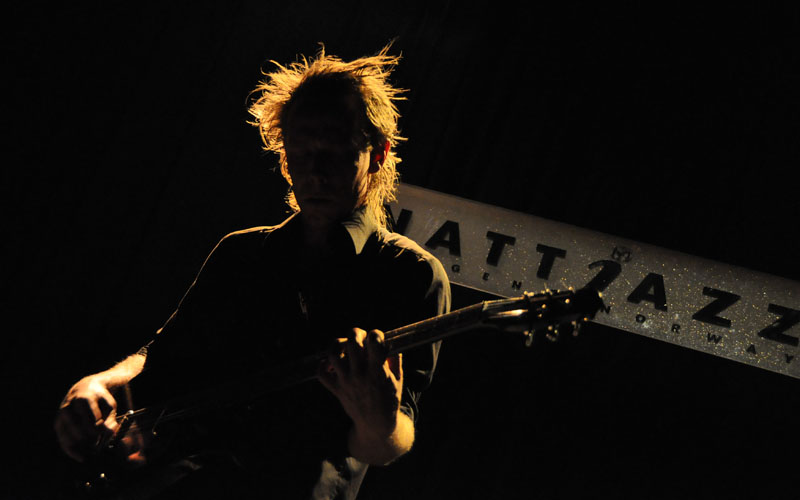
While Westerhus is, like Aarset, a player for whom altered techniques and electronics are fundamental to a style that largely eschews guitar conventions, those expecting his work with Molvær to carry on Aarset's more ethereal soundscapes will be surprised...and shocked. Westerhus is, indeed, his own man, with an approach that stretches the boundaries of improvisation, and so his work with the trumpeter can be expected to travel to more aggressive landscapes and alien soundscapes where the guitar is more a controller of sound than a melodic or harmonic instrument. All this and more was in full evidence during his boundary busting solo performance at Studio USF.
Despite his busy touring schedule with Molvær, Westerhus' primary focus is increasingly on solo performance, and simply entering Studio USF before the show made clear that this was to be one like no other. Four amplifiers—two Ampegs, one Hiwatt and the Vox AC30 that's become so signature to the sound of Aarset and Terje Rypdal—and an array of pedals that literally went from one end of the stage to the other spoke to the key importance of technology in Westerhus' music. But his hour-long set of free improvisation was not a case of technology-meets-guitar; it was deeper than that. Instead, Westerhus' instrumental array was as much a part of his DNA as the instruments he used to control it—a conventional Gibson slim-line hollowbody and a Danelectro Longhorn electric baritone guitar.
Starting in darkness on the baritone, Westerhus began by slapping and scraping the strings. Loops, pitch shifters and more became a part of the picture as he slowly began to develop an aural landscape that had little to do with melody and more to do with colors dark and industrial. While Westerhus—as much a product of Slayer as he is Derek Bailey—possesses no shortage of virtuosic technique, an unshakable irreverence and utter disrespect for convention meant that there were few reference points for the increasingly dense, increasingly loud and increasingly stunning sounds emanating from the stage. Despite few of the usual touchstones that might be expected in a solo guitar performance, trace elements of pulse, melody and harmony came and went in constant ebb and flow, as Westerhus plucked, pulled, struck, bowed and scraped his strings.
Westerhus' lack of reverence became even clearer at one point where, ripping the cable out of his baritone guitar, he seemed ready to switch to his Gibson. Instead, rather than plugging it in, he spent minutes touching the tip of the cable to create jagged electronic noise, which he further processed through his pedal array—triggered (sometimes simultaneously) with both feet and, dropping to his knees, his hands as well. Some might suggest that Westerhus' music, in its apparent lack of conventional structure, is nothing more than aimless meandering and knob-twddling. But watching him in performance only further supported the actual truth: this is simply not the case. Westerhus' command of his pedals and devices is so intimate, so complete, that while it would be true to call his music spontaneous and of-the-moment, it would be a mistake to suggest that he is in anything but complete control, even as he performs with seemingly reckless abandon. The thrill of discovery may have been fresh for Westerhus, as he found new ways to combine the seemingly endless permutations and combinations of his gear, but there was never any doubt that he knew exactly what he was doing.

Noise much of it may be, but, as Norwegian noise improve progenitor Supersilent continues to demonstrate, that needn't mean there's no room for beauty. In a set that cut a broad swatch of dynamics and sound, Westerhus' mesmerizing performance proved that for the open-minded—for those able to accept that standard musical conventions need not be adhered to in order to create meaningful music—it's possible to be simultaneously soothed and attacked by the utter and vast potential of sound.
May 28, 2010: Eivind Aarset Sonic Codex
The problem with a festival running simultaneous shows in three rooms means that either choices have to made, or it becomes necessary to leave one performance early in order to catch parts of another. With two guitarists as important as Stian Westerhus and Eivind Aarset playing at the same time, the only possible choice was to leave one early and show up at the other part-way through its set. Aarset, who was the subject of an extensive AAJ interview earlier in 2010 to coincide with the release of Live Extracts (Jazzland, 2010), was in Sardinen with a double-drummer version of his Sonic Codex group, and missing the first part of his performance was as difficult a decision as leaving Westerhus' set, as both were thoroughly compelling in their own distinct ways.
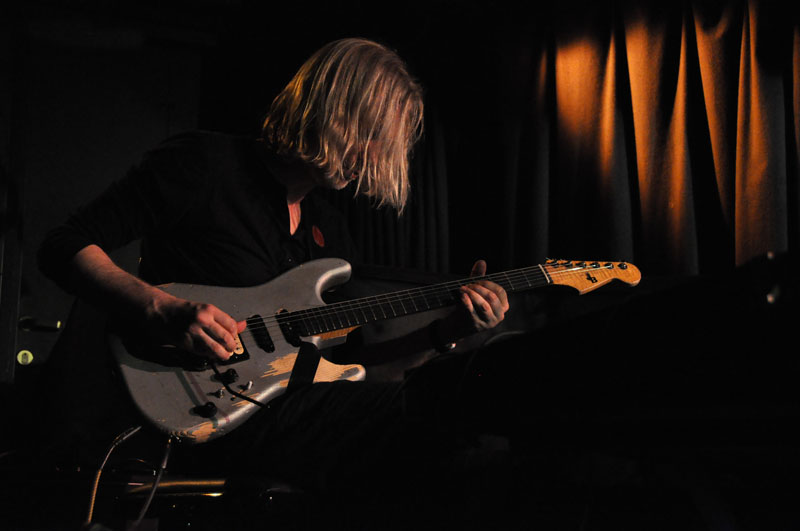 Eivind Aarset
Eivind Aarset Drummer Wetle Holte has been with Aarset dating back to the guitarist's second album, Light Extracts (Jazzland, 2002), while bassist Audun Erlien—heard with trumpeter Mathias Eick a couple nights back—joined up with Aarset at the time of Sonic Codex (Jazzland, 2007). Drummer Erlend Dahlen, also heard with Eick, has been touring with Aarset's larger groups—this quartet and the expanded, six-piece Sonic Codex Orchestra—for the past couple years. During Aarset's set, the two drummers came together for some powerful in-tandem kit work, but they also contributed strong individuality as well. As in his performance with Eick, Dahlen added bowed saw to the mix—as well as vocals—during the powerfully balladic "Still Changing." He also played steel drum and some additional tune percussion, as did Holte, who contributed some additional electronics to Aarset's expansive aural landscapes.
Seeing Aarset and Westerhus back-to-back only emphasized how innovative, yet completely different, the two guitarists were. Aarset's approach to sound was equally forward-thinking, but his playing—despite use of devices like an eBow to create flowing, sustaining melody lines and gently tapping the body of his guitar to create sounds rife for processing—was more overtly guitaristic, as he used unusual voicings and odd intervallic leaps in his melodies to create music that was unmistakable and unique, yet still closely aligned to conventional concepts of time, melody and harmony. He proved a deeply lyrical player as well, capable of stunning virtuosity, but largely focusing, instead, on soundscapes and building a collective ensemble sound that combined elements of jazz and progressive rock...even, during the angular "Electromagnetic," hints of King Crimson-like Nuevo metal.
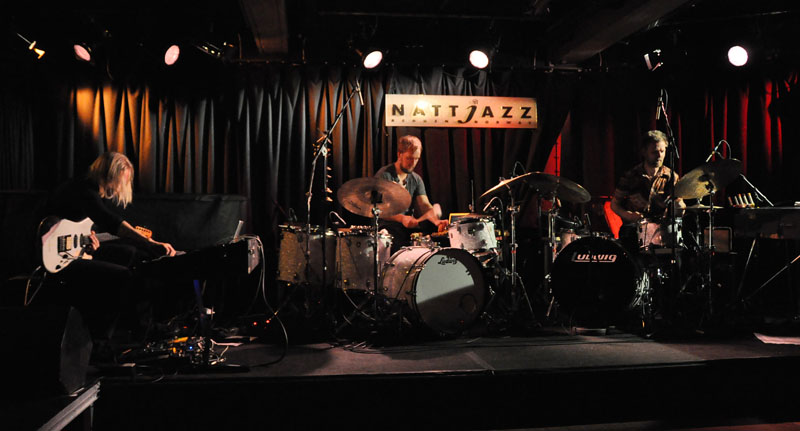 From left: Eivind Aarset, Wetle Holte, Erland Dahlen (missing, Audun Erlien)
From left: Eivind Aarset, Wetle Holte, Erland Dahlen (missing, Audun Erlien) Like Aarset the person, Sonic Codex's music took its time to unfold, gradually revealing more as it built from near-ambient atmospherics to ear-shattering crunches—where what was coming from the stage was so dense that it was hard to imagine so much sound coming from just one guitarist. Erlien created a solid anchor when the music demanded it, but wasn't afraid to kick in a distortion pedal and deliver harshly overdriven lines and powerful in-the-gut sonics. Aarset—who still plays in duo and other special projects with Molvær as well as with trumpeter Arve Henriksen and live sampler Jan Bang—is known primarily as a sound sculptor in his extracurricular activities. In his own work, while it's a relatively rare occurrence, he does break out with some guitar pyrotechnics here and there, as he did during the slow burn of "Sign of Seven." With a mad scientist's array of foot pedals, and even more on a table in front of him along with a laptop computer, Aarset's command of sound and intimate knowledge of gear yields new sounds as spontaneously as the lines and chords he plays. Live Extracts is a terrific document of Aarset's two working bands, but even it can't capture the visceral energy and expansive sounds that this guitar anti-hero proves capable of in performance, time and time again.
May 29, 2010: Cornelius på Holmen/JNiaN 2010 Draws to a Close
With a number of JNiaN attendees leaving early on the morning of May 29, many goodbyes were made late in the evening at the Key Club, though the general consensus has always been that it's never goodbye, but simply "until next time." Those who remained on the 29th, leaving the following day, were treated to one more programmed event, courtesy of JNiaN—a repeat of the 2009 trip that took people, by boat, to an island off the coast of Bergen, to Cornelius på Holmen. A restaurant with a simple premise—only serve food fresh from the surrounding waters and lands—Cornelius på Holmen provided one last opportunity for everyone to get together over a meal, talk about what they'd seen and heard, and make some plans for keeping in touch.
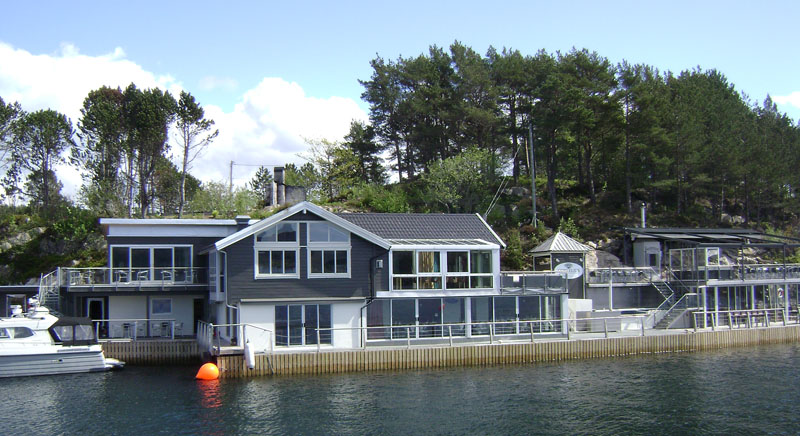 Cornelius på Holmen
Cornelius på Holmen The island has been built up from a preexisting landscape, and its eco-friendliness goes beyond simply serving what it catches (divers go into the water daily to bring in a variety of seafood). The restaurant is actually designed to naturally manage such things as the temperature of a basement wine cellar, cooled by the surrounding waters. A buffet of fresh crab legs, mussels, prawns, crab bisque and more, along with a fine wine chosen by the restaurant and explained in great detail by its host, created a warm and relaxed context for even more first contacts, as members of JNiaN met with other international journalists, who were also in Bergen to cover the Bergen International Festival, as well as additional members of the Norwegian Ministry of Foreign Affairs.
It was an informal way to continue an endless dialogue, where people from around the world shared their impressions of JNiaN and Nattjazz as well as their own work. But, after the return to Bergen, it still wasn't over, as many of the remaining attendees went back to USF Verftet for one last evening of dinner, Nattjazz and more "until next times." With early flights and packing to do, there was only a little time for music, but attending even part of pianist Helge Lien's wonderful trio show at Sardinen was as great a way to say goodbye to Nattjazz 2010 as could be imagined.
Lien's most recent album, Hello Troll (Ozella Music, 2008), was a fine an introduction to a trio that's been together for nearly a decade now, and has released six titles—in addition to Hello Troll, three discs on the Japanese DIW label and two on Norway's Curling Legs. While it would be easy to draw some comparison to another longstanding Scandinavian piano trio, e.s.t.—whose career was cut short when its pianist, Esbjorn Svensson, died tragically in a diving accident—the two groups couldn't be more dissimilar. True, both groups are comprised of players of remarkable virtuosity, but while e.s.t. increasingly integrated electronics into the mix—in particular bassist Dan Berglund, whose overdriven double-bass brought a metal tinge to the trio—Lien and his trio remain an all-acoustic ensemble, and one that's less informed by the pop sensibility that gave e.s.t. its reach to a wider audience.
 From left: Knut Aaleflæt, Helge Lien, Frode Berg Helge Lien Trio, Performing at Punkt 2009
From left: Knut Aaleflæt, Helge Lien, Frode Berg Helge Lien Trio, Performing at Punkt 2009 If there's any place for direct comparison with e.s.t., it would be with that group's final release, Leucocyte (ACT, 2008), an anomaly of a disc for the group in its all-improvised construction. That record signaled something of a new direction that, sadly, would never be fully realized, while the potential of Lien's trio continues to grow. Lien is a strong composer, but what links his music to e.s.t.'s final recording is this: while Lien writes music that contains challenging compositional constructs, when it comes to interpretation, there's a fluid and empathic chemistry between the pianist, bassist Frode Berg and drummer Knut Aaleflæt that makes every performance a rich and transcendent experience, reflecting the value of a longstanding lineup, one for whom instinct and intuition only grow with time.
Lien's music is deeply rooted in the jazz tradition, his Live (Curling Legs, 2005) even including a radically reworked and improv-heavy version of Paul Desmond's iconic "Take Five," made famous during Desmond's tenure with the Dave Brubeck Quartet. Lien's Nattjazz performance—in part a commissioned work by the festival—remained clearly focused on new original material, however, and a sound that combined the romanticism of Bill Evans and unfettered interactive interplay of Brad Mehldau with no shortage of the melancholy lyricism that made Esbörn Svensson so engaging. The musical camaraderie among the members of Lien's trio was palpable. Berg proved capable of an unshakable foundation, but in a solo during the trio's encore, he demonstrated a staggering, lithe muscularity and round, woody tone no doubt rooted in the work of fellow Norwegian, bassist Arild Andersen. Aaleflæt was all smiles throughout the set, moving seamlessly around the kit whether playing with his hands, sticks or brushes, with just enough added hand percussion to inject additional color when that need superseded rhythmic demands.
But while the tradition is endemic to the trio's work, so too is the influence of classical music, made all the more real when Berg played unison arco lines with Lien. Despite Nattjazz being a festival that runs the risk of disturbances, as audience members move from room-to-room and show-to-show, one of the most surprising aspects of the festival in general, and this performance in particular, was that when Lien and the trio brought the dynamics down so quietly that it was almost necessary to lean forward to hear them. The audience was absolutely, drop-dead silent—a rare enough quality even in more pristine concert environments and a testimony to the commitment and engagement of both the audience and Lien's trio. With a new album in the works for possible release in 2011, Lien's Nattjazz performance set the bar high for his follow-up to Hello Troll.
A quick visit to the Key Club for some additional farewells, and it was time to pack, catch a few hours' sleep, and head to the airport for the long flight home. As always, JazzNorway in a Nutshell proved a combination of comfort and revelation. Comfort came in the meeting up with old friends—industry people, journalists, artists and members of advocacy organizations from around the world—and the opportunity to experience musicians in performance that had previously only been heard on record. Revelation derived from the opportunity to interact with new friends and colleagues, and artists previously unheard. Traveling home with a suitcase filled with music, literature and photos, there's more than enough to keep the memory of JNiaN 2010 alive, but even more important will be the contacts maintained throughout the year in the hopes of reconvening yet again for JNiaN 2011. It's hard to imagine an event to top JNiaN 2010, but thanks to Lars Mossefin, Bo Grønningsæter and Brit Aksnes—as well as all the representatives from various other Norwegian organizations—and a history that has proven each successive year to be even better than the last, there's little doubt that JazzNorway in a Nutshell 2011 will be something to anticipate.
Visit Nattjazz, Gunhild Seim, Mathias Eick, 1982 Trio, Frøy Aagre, Maria Kannegaard, Bergsdalstunet, Mari Kvien Brunvoll, Motif, Stian Westerhus, Eivind Aarset and Helge Lien Trio on the web.
Photo Credits
Page 1: John Kelman
Page 2, 4, 6: Luca Vitali
Page 3, 1982 Trio and Nils Økland: Luca Vitali
Page 3, Frøy Aagre: Courtesy of Frøy Aagre
Page 5, Mari Kvien Brunvoll: Luca Vitali
Page 5, All Other Photos: John Kelman
Page 7, Eivind Aarset: Luca Vitali
Page 7, Cornelius på Holmen: John Kelman
Page 7, Helge Lien Trio: Jan Hangeland
2008 | 2009 | 2010 | 2011
Tags
Live Reviews
John Kelman
Norway
Bergen
Nils Petter Molvær
Arve Henriksen
Dave Douglas
john zorn
Ornette Coleman
Andrew D'Angelo
Hakon Kornstad
Eberhard Weber
Jacob Young
Jon Balke
Andreas Ulvo
Frøy Aagre
Terje Rypdal
Eivind Aarset
Helge Lien
Jaga Jazzist
Kenny Wheeler
Miles Davis
Clifford Brown
Han Bennink
Jan Garbarek
Dave Liebman
John Coltrane
Arild Andersen
Jon Christensen
Maria Kannegaard
Bobo Stenson
Bugge Wesseltoft
Eivind Opsvik
Pete Cosey
Mahavishnu Orchestra
Sidsel Endresen
Dexter Gordon
Peter Brötzman
Ken Vandermark
Alexander von Schlippenbach
Sam Rivers
Derek Bailey
Esbjorn Svensson
Dan Berglund
Paul Desmond
Dave Brubeck
Bill Evans
brad mehldau
PREVIOUS / NEXT
Support All About Jazz
 All About Jazz has been a pillar of jazz since 1995, championing it as an art form and, more importantly, supporting the musicians who make it. Our enduring commitment has made "AAJ" one of the most culturally important websites of its kind, read by hundreds of thousands of fans, musicians and industry figures every month.
All About Jazz has been a pillar of jazz since 1995, championing it as an art form and, more importantly, supporting the musicians who make it. Our enduring commitment has made "AAJ" one of the most culturally important websites of its kind, read by hundreds of thousands of fans, musicians and industry figures every month.


